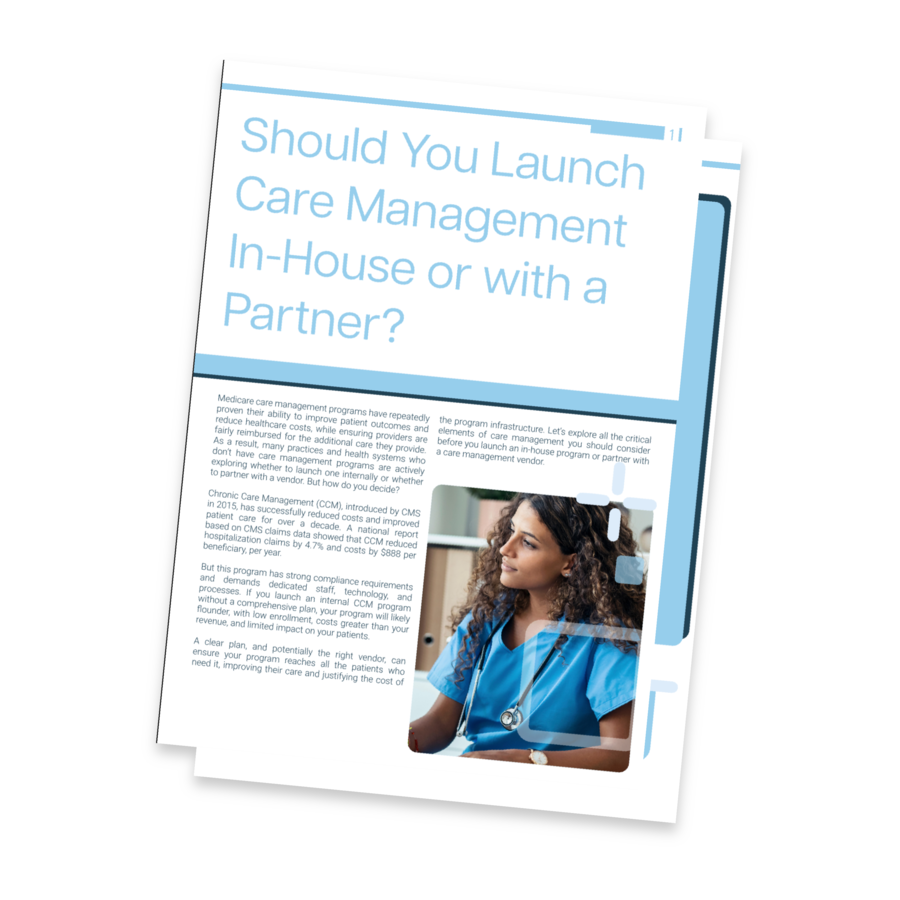
Talk with a ChartSpan Representative Today!
Our team is ready to help you improve patient care and outcomes.
Blog
Rural Healthcare Challenges, Disparities, & Opportunities with Chronic Care Management
Delivering high-quality rural healthcare entails addressing challenging health disparities, managing strained infrastructures, and overcoming numerous barriers to accessibility. Rural communities are statistically older and face more health challenges than their urban counterparts. These patients often lack access to financial and educational resources to navigate the healthcare system effectively. The scarcity of rural healthcare professionals and long distances between hospitals further complicate the administration of high-quality care to rural patient populations.
In this blog, we'll explore the obstacles confronting healthcare providers, hospitals, and clinics operating in rural communities. We will also examine how Chronic Care Management (CCM) services offer innovative solutions to healthcare delivery in rural regions and how ChartSpan’s turnkey CCM program can transform the care Rural Health Clinics (RHCs) provide their chronically ill patients.
What is rural healthcare?
Rural healthcare refers to providers, hospitals, and clinics that deliver medical services and resources to non-urban communities, where geographic isolation and overburdened infrastructures pose unique challenges. These healthcare providers and organizations must overcome health disparities and barriers to patient accessibility when delivering high-quality, patient-centered care to rural populations.
Healthcare access in rural communities
Rural patient populations tend to be older, less affluent, and more impacted by chronic health conditions than their urban counterparts. Rural residents are at higher risk of death from cancers, heart disease, stroke, diabetes, and unintentional injuries resulting from opioid misuse and substance abuse. They are also more likely to have multiple chronic conditions compared to Americans of the same demographic living in other areas of the country.
Widespread uninsurance, lower household incomes, food deserts, tobacco use, and a lack of health education resources all contribute to rural residents facing these significant health challenges. These disparities also result in rural residents using healthcare resources less frequently than urban residents.
Rural residents face barriers to accessing healthcare that are less prevalent in other communities. Lack of access to providers and specialists, distance from health clinics, under-insurance or absence of insurance, and poverty all contribute to rural populations' being less likely or unable to seek preventive care. Rural patients tend to use healthcare services primarily for emergencies, leading to greater instances of avoidable hospitalizations and more expensive clinical interventions.
8 challenges in delivering rural healthcare
Rural communities present many challenges to the healthcare providers and practices within them. Understanding these accessibility barriers and their root causes can help providers overcome them and facilitate better health literacy, higher engagement rates, and positive clinical outcomes for rural residents.
1. Lack of rural providers and specialists
Although over 15% of the American population resides in rural areas, less than 10% of the nation’s physicians practice healthcare in these communities. Rural areas face difficulty recruiting and retaining medical professionals due to lower salaries, limited career advancement opportunities, and geographic isolation. As a result, many rural communities lack the appropriate number of providers to meet the population's healthcare needs. This results in overworked providers and clinical staff and insufficient resources.
Furthermore, most physicians practicing in rural areas are primary care physicians or generalists. Specialists are far more likely to practice health in urban areas. As an immediate result of this inequitable distribution of subspecialists, patients in rural communities often lack expedient access to specialized care.
The number of practicing primary care physicians in the United States continues to decline, as most internal medicine residents opt to practice as medical subspecialists instead of general internists. This means rural communities will continue to face provider shortages and struggle with attracting new healthcare professionals.
2. Aging rural populations
According to the U.S. Census Bureau’s 2019 findings, 17.5% of rural residents were over 65. In contrast, 13.8% of urban and suburban residents were 65 or older. 22% of Americans older than 65 live in rural areas, highlighting a disproportionate distribution. Older adults face an elevated risk of developing chronic illnesses like cancer, coronary heart disease, respiratory illnesses, chronic kidney disease, and diabetes. They also face higher rates of morbidity from these conditions.
3. Lower household income and higher poverty rates
Rural Americans are more likely to fall below the poverty line than those living in other communities. According to a 2019 United States Department of Agriculture Economic Research report, 15.4% of rural Americans fall below the poverty line, as opposed to 11.9% of Americans in urban areas.
Low household incomes and poverty negatively impact an individual’s healthcare access. Tight financial resources can contribute to poor nutrition, lack of reliable transportation to access health services (which may require long drives in some rural communities), and an inability to afford medical services and medications.
Lower-income jobs also tend to offer lower-quality insurance and healthcare compensation packages. Financial instability can result in individuals forgoing services like oral healthcare, family planning, behavioral health, and preventive services, which could all facilitate positive health outcomes. One study found as many as 36% of rural Americans reported skipping medical care because they could not afford the cost of services.
4. Uninsurance and under-insurance
Rural Americans are uninsured at higher rates than those living in urban areas. The US Census found that 12.3% of rural residents were entirely without health coverage. Rural residents are less likely to have private insurance and accompanying health benefits offered to them through their workplace. Many rural residents are self-employed in agricultural professions, depriving them of access to high-quality company benefit packages.
5. Distance from healthcare services and lack of transportation
Rural residents must travel further and longer to receive medical care than their urban counterparts. In 2021, the U.S. Government Accountability Office reported that rural residents traveled an average of 20 miles farther for inpatient care and around 40 miles farther for specialty care than urban residents.
The lengthy commutes required to seek medical care often result in rural residents delaying or forgoing critical services. If they are self-employed in the agricultural profession or precariously employed in a low-income job, they may be less likely to request the necessary time off to seek care, especially for non-essential and preventive services. Furthermore, rural areas rarely have public transportation systems. This can limit transportation access for those unable to operate or afford a reliable vehicle.
6. Food deserts and high obesity rates
Obesity rates among adults in rural areas are significantly higher than those in non-rural areas. Around 34.2%% of rural adults are obese, compared to 28.7% in metropolitan areas. Obesity is linked to a long list of chronic illnesses and compounds injuries and chronic pain.
Many rural residents live in “food deserts” and lack access to nutritious dietary options. Low-income rural households are more likely to experience food insecurity and rely on cheap, highly processed foods to feed their families. These foods can contribute to obesity and often lack nutritional value.
7. Prevalence of tobacco use
Tobacco use is more commonplace in rural communities than in urban centers, specifically in Southern and Midwestern regions. Residents of rural communities die from tobacco-related lung cancers 18-20% more than urban and suburban residents.
Furthermore, smoking and tobacco use are major contributing factors to four of the five leading causes of death in rural communities. Heart disease, cancer, chronic lower respiratory disease, and strokes are all exacerbated by, if not the direct effects of, tobacco consumption.
8. Lower health literacy
Communication barriers present many challenges for rural healthcare practices. When patients understand their diagnoses, treatment options, and medications, they are more likely to adhere to wellness plans constructed by their care providers.
However, rural residents may have lower health literacy when compared to other parts of the country. These patients often have less educational attainment than urban patients, a primary indicator of health literacy. Communication with healthcare professionals is usually brief and may contain medical language that is not adequately explained. Written medical information could be complex and written at an advanced reading level.
Many healthcare practices’s limited resources and remoteness make educational campaigns more difficult. Around 22% of rural Americans lack access to broadband, which has been associated with greater engagement with health literacy and telehealth services. Due to the scarcity of rural providers and a cultural history of home remedies, patients may mistrust medical services and be hesitant to engage with them.
Rural Health Clinics (RHCs) address the many challenges posed by rural regions, delivering healthcare to patients despite the obstacles posed by geographic isolation, lower health literacy, and poverty. These CMS-certified clinics provide high-quality care to underserved rural communities and increase primary care access for rural residents. They offer screenings, vaccinations, wellness planning, and basic laboratory and emergency services for injuries and acute illnesses.
The benefits of Chronic Care Management (CCM) for Rural Health Clinics (RHCs)
Chronic Care Management (CCM) is a billable Medicare program designed to improve the quality of care delivered to patients with multiple chronic conditions. CCM is a value-based care service that identifies and helps close gaps in care, creates a consistent cadence of communication with patients, and improves care coordination.
CCM offers extraordinary benefits to Rural Health Clinics that can help them overcome the challenges presented by delivering healthcare in underserved rural communities. Additionally, adequately managed CCM programs open up a much-needed extra revenue stream for RHCs.
Learn more: The profound effect of CCM on patient outcomes
Remote check-ins with rural patients
Many rural patients find healthcare services difficult to access. Long travel distances, patient transportation limitations, and fewer available providers can contribute to infrequent engagement with health services. However, patients receive a dedicated monthly call from a professional and compassionate care manager through CCM. This adds twelve touchpoints of communication annually for each patient.
For patients managing chronic illnesses, this consistent cadence of communication can be life-saving. If a patient expresses concern over a new or worsening symptom, the care manager can use the call to encourage the patient to seek out appropriate care. This ongoing education helps strengthen patient health literacy, facilitating patient empowerment and engagement in their healthcare journey.
These calls can also be used to check in with patients on their providers' treatment plans. They offer patients regular opportunities to discuss medications, upcoming appointments, and lifestyle changes.
Care managers can provide patients with self-management tips and educational materials, keeping them adherent to their wellness plans and avoiding the emergence of gaps in care. Without these regular calls, some patients may discontinue or abandon their treatment goals, resulting in deteriorating conditions that necessitate emergency services.
Learn more: Care Manager vs. Case Manager: Differences and Benefits
Assistance with nutrition, transportation, and other Social Determinants of Health (SDOHs)
Rural residents in food deserts struggle to access nutritious foods. They often do not have access to public transportation, and ride-sharing services are more scarce. Higher rates of poverty and low household incomes also create financial stress that can cause rural patients to avoid health services.
Understanding and addressing these Social Determinants of Health (SDOHs) is crucial to delivering high-quality and effective care to patient populations. SDOHs are the social and economic realities through which patients navigate their daily lives, and they have enormous implications for patient health management and clinical outcomes.
Through CCM, providers can learn about patients’ SDOH needs before they imperil their health. The monthly calls provide patients ample opportunities to share financial and emotional challenges with care managers. If a care manager suspects a patient may be struggling, they can perform tailored SDOH screenings on enrolled patients, identifying nutritional, emotional, and monetary needs.
In turn, CCM care managers can connect patients to local resources like food pantries, housing services, or support groups. They can also administer depression screenings, share their findings with a patient’s primary care provider, and connect patients to mental health professionals.
Care managers can also arrange transportation assistance for patients to ensure they can make their scheduled clinical appointments and receive medication. Without reliable transportation, a patient may miss a preventive screening or an A1C test. This could deprive them and their providers of crucial insights into their illness management, leaving developing conditions undetected. CCM services prevent gaps in care from emerging due to a lack of transportation access.
Learn more: Loneliness and Chronic Care Management
24/7/365 access to nurse care line
Rural patients reside in remote areas that may be miles away from their nearest neighbors, not to mention urgent care or hospitals. Providing them with around-the-clock access to clinical guidance can be transformative for this patient population.
CCM programs offer enrolled patients 24/7/365 access to a nurse care line, where patients can call in to discuss questions or concerns about their health regardless of the hour or day. The nurse care line coordinators can offer critical medical insight to these patients, helping them gauge the severity of their symptoms and recommending a course of action.
Rural residents are also more likely to be isolated and may not have a community to assist them in processing their healthcare journey. The nurse care line ensures that CCM-enrolled patients are never alone. There is always a professional, empathetic voice to help patients work through their frustrations, medications, and anxieties. In addition to offering potentially life-saving medical guidance, these care lines provide patients invaluable human connection and reassurance.
Learn more: Chronic Care Management: Benefits, Requirements, & Reimbursements
What are the challenges of implementing CCM in RHCs?
In a recent Porter Research study, nearly half (47%) of RHCs reported they do not offer their patients a chronic care management (CCM) program, even though it offers $67/patient/month in much-needed recurring revenue*. It’s a stunning statistic, considering CMS claims data shows patients enrolled in a CCM program cost and spend less on out-of-pocket health expenses.
Successfully implementing an in-house CCM program is complex and time-consuming, and overburdened RHCs often lack the resources to take full advantage of the service. The same recent Porter Research Study found that 73% of respondents who offer CCM services rely on their own resources and their EMR system to manage the program.
However, most EMR systems are not equipped to handle the unique needs of chronically ill patients, and RHCs typically do not have access to the volume of qualified resources required to manage a successful CCM program. This DIY approach typically results in fewer patients receiving access, frustrated administrators, and, ultimately, program abandonment.
*Results may vary by provider.
Maximize the quality of rural healthcare with ChartSpan’s CCM program
ChartSpan is an innovative, industry-leading provider of CCM services designed to streamline implementation and allow your practice to focus on caring for your community. We’ve helped RHC networks like Weisbrod Health transform their care by implementing fully managed CCM.
ChartSpan alleviates the enormous pressures brought on by operating an in-house CCM program. We assist your practice at every stage, aiding in patient eligibility identification, handling program enrollment, and managing patient churn. We provide your practice with a team of highly trained care managers who are ready to assist rural patients with their unique challenges.
We also offer our 24/7/365 nurse care line to your rural patients, giving them critical, around-the-clock access to clinical feedback. As patient care gaps are closed and clinical outcomes improve, your practice will benefit from improved quality score metrics and more satisfied patients.
ChartSpan also helps your practice maximize the additional revenue stream CCM brings. With just 300 enrolled patients, your practice could see a $125,000 increase in annual revenue*. Our proprietary RapidBill™ technology allows you to review codes and bill Medicare seamlessly. We also keep extensive documentation on every enrolled patient’s journey and archive these records for a decade. Our thorough and secure documentation meets the rigorous requirements of CMS, ensuring you remain compliant.
If you are an RHC or rural healthcare practice and you’re curious about how ChartSpan can help you tackle the challenges presented by rural healthcare, contact us today to learn more about our CCM program.
*Results may vary by provider.
You may also like:
Subscribe for More Insights
Get valuable resources delivered straight to your inbox.
"*" indicates required fields






